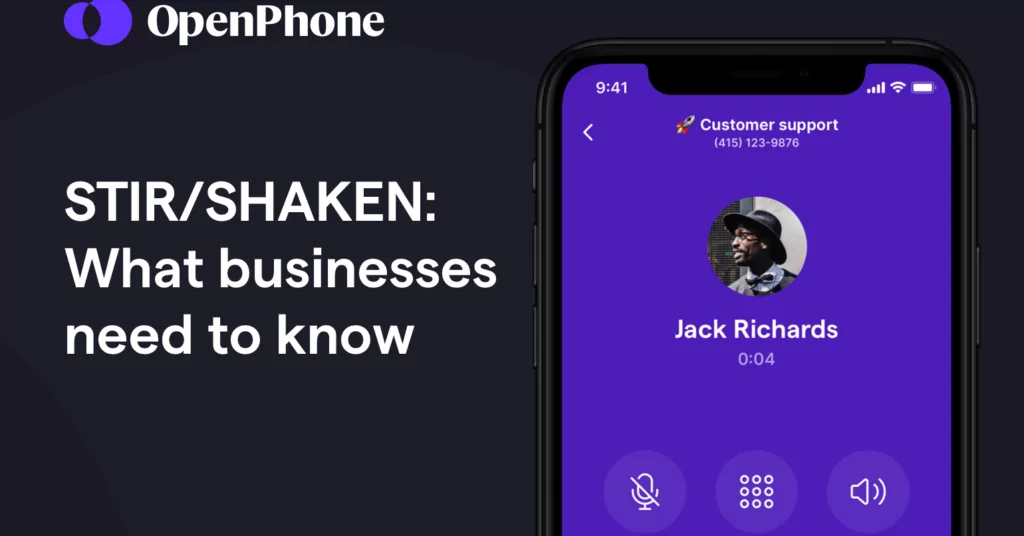Spam has gotten out of hand. That’s easy to see for anyone who uses a mobile phone on a daily basis. But while spam calls are an annoyance, it’s easy to simply ignore calls from unknown numbers and let them go to voicemail — except for businesses.
Most companies don’t have the luxury of ignoring incoming calls from numbers they don’t recognize. If there’s a chance that a call could be a business opportunity, you can’t ignore it.
In response to the growing volume of spam calls, the US Federal Communications Commission (FCC) announced STIR/SHAKEN in an attempt to help stamp out bad actors.
Read on to learn more about how these new FCC mandates may impact your team and everything we’re doing for OpenPhone customers in response to STIR/SHAKEN.
What is STIR/SHAKEN?
STIR/SHAKEN (sometimes referred to as SHAKEN/STIR) is a protocol mandated by the FCC under the TRACED Act to combat unwanted robocalls and unlawful caller ID spoofing. With STIR/SHAKEN protocols, carriers may flag non-compliant callers on the recipient’s caller ID as:
- Possible spam
- Suspected robocall
- Scam likely
That should allow anyone to easily spot spammers and know which calls they can safely ignore.
STIR/SHAKEN includes new technical standards for authenticating caller ID information. Essentially, the outbound caller’s provider helps identify their caller ID as trustworthy. Phone providers can verify where calls originate from and can send an authentication signature to other providers that the call recipient may be able to see.
There are three levels of verification (STIR/SHAKEN refers these to as attestation) that phone providers can offer for outbound calls:
- A-level attestation – The phone service provider attests to where calls originate from and the user is authorized to use the number.
- B-level attestation – The service provider authenticates the call’s origin. However, they can’t verify the specific caller is authorized to use the number.
- C-level attestation – The service providers can confirm the call came from their network but can’t confirm the source.
If your team makes frequent outbound calls, here are a few steps OpenPhone users can complete right now so your team has A-level attestation — and most importantly, aren’t mistakenly labeled as spam.
Register with the FCC and carriers
Have a business phone system with us and complete a high amount of outbound calls? We provide teams a streamlined way to register all the phone numbers in your OpenPhone workspace with the FCC at once. Don’t worry if you’re unsure whether the number of outbound calls you complete qualifies as significant — we’ve proactively emailed high-volume outbound call customers.
If you have an active account with OpenPhone (not on a trial) and wish to register, check out our Help Center guide to US carrier registration for more information on how to apply. This form also helps you comply with new emerging A2P 10DLC guidelines for texting. Once your application is approved, we’ll automatically associate any new numbers you purchase on your account with your business profile. ✅
Next, you can register with the Free Caller Registry. This is a separate process we’re not able to submit on your behalf. The information you provide on that site is used by major US wireless carriers, including T-Mobile, Verizon, Sprint, US Cellular, and AT&T. That way, you don’t have to worry about your calls being accidentally flagged as spam. Keep in mind if you add a new number into your OpenPhone workspace, you’ll need to register the number with the Free Caller Registry.
Any OpenPhone customers that register their business phone number(s) with the FCC receive A-level attestation.
After gaining A-level attestation, your call recipient’s carrier may even present a trust indicator like “Caller Verified” when they receive your call. Trust badges are a new concept though, so it may take time for carriers to implement them.
How to keep A attestation
FCC registered numbers can still be flagged if outbound call patterns show a sudden spike in volume. The same applies if consumers report your calls as spam or in a fraud report.
To stay at A level, you’ll need to maintain your caller reputation and avoid being labeled as spam.
Here are a few best practices to help you keep A attestation:
- Maintain a regular outbound call volume without unusual spikes. Ramp up your call volume incrementally instead of hitting your full target amount on the first day of a new campaign.
- Follow Telephone Consumer Protection Act (TCPA) requirements including adhering to all “Do Not Call” lists and TCPA opt-in/opt-out requirements if your business texts.
- Regularly update your calling lists and remove sunset numbers that don’t connect. Low call answer and completion rates are associated with spam, so you’ll want to remove disconnected numbers from your list and avoid dialing random numbers.
- Give call recipients a clear identification of what business is calling them and simple instructions for opting out of future calls.
- Avoid using neighbor numbers to cold call large amounts of people with the same area code.
- Create dedicated phone numbers for specific outbound functions whether it’s support or surveys, especially if you run outbound call campaigns.
If you have any questions about how STIR/SHAKEN may affect your OpenPhone account, reach out to our support team.
